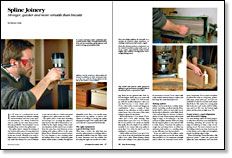
Synopsis: Steven Cook explains what a spline joint is and how it saves production time and money. He discusses the right equipment to use, how to make splines, and how to use them in frame joinery, panel alignment, and decorative edging. He shows you how to cut grooves with a router and a slotting cutter.
In 20 years as a professional woodworker, churning out cabinets, making custom furniture and even some musical instruments, I’ve always looked for ways to make my two-man shop productive and profitable. One technique I use in virtually all my work is the spline joint.
The spline joint is simply the joining of two boards with a piece of scrap plywood or hardwood that’s set into grooves routed in the two boards. Whether you need to align boards to be joined for a large tabletop, make face frames for a set of cabinets or join rail and stile for a frame-and-panel or glazed door, spline joints are useful.
The spline joint is easier than doweling and stronger, too. Locating the splines is easy because the critical dimension is controlled by the depth setting of the router (see the photo at left). Just be sure to index from the same face, and whatever you’re joining with splines will be in the same plane. Since I already have several routers, it’s a lot cheaper to use a slotting cutter and splines than to buy a dedicated plate joiner, which makes a similar, though less adaptable, joint. Also, I use mostly scrap plywood for my splines, so there’s less chance of swelling or having the spline telegraph through to the surface than with conventional compressed birch biscuits.
The right equipment: a good slotting cutter
Other than a router, the only item you need for spline joinery is a slotting cutter, a generally available router bit. These come in many diameters and slot widths, but choosing the right one needn’t be confusing. There are two general rules. First, select the largest shank size your router will accommodate—usually 1 ⁄2 in. And second, go with the smallest diameter cutter you can find because a 1⁄4-in. shank and a 13 ⁄4-in. cutter make a weak and dangerous combination. I have a couple of bent shanks in my collection, as well as ruined router bases, due to the mass of the cutter being too great for the shank.
My favorite bit has a 1 ⁄2-in. shank, 15 ⁄16-in. cutter and a 3⁄4-in. pilot bearing. That means there’s just over 1 ⁄4 in. of cutter in the wood, and the 1 ⁄2-in. shank can handle that easily. Also, the depth of cut, which is actually 9 ⁄32 in., means that your spline is more than 1 ⁄2 in. wide (9 ⁄32 and 9 ⁄32 are 9 ⁄16), making for a strong joint.
From Fine Woodworking #109
For the full article, download the PDF below:
Fine Woodworking Recommended Products

Suizan Japanese Pull Saw

Pfiel Chip Carving Knife

Veritas Precision Square




















Log in or create an account to post a comment.
Sign up Log in